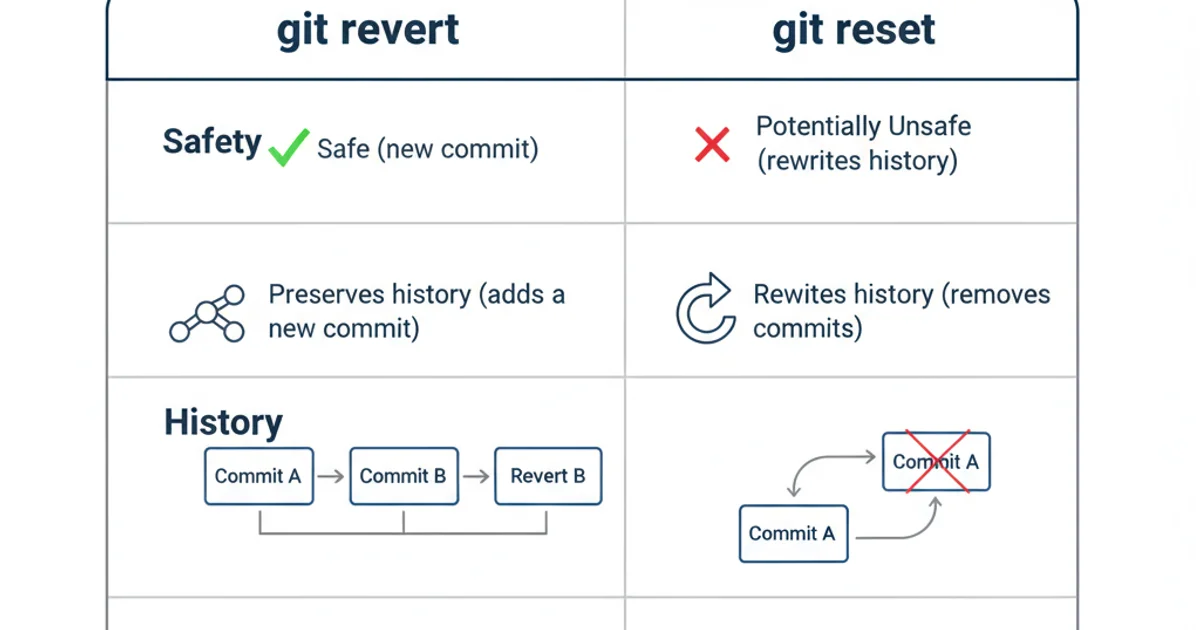How do I reverse a commit in git?
Categories:
How to Reverse a Commit in Git: A Comprehensive Guide

Learn the essential Git commands to undo or revert commits, understanding the differences between git revert and git reset for safe and effective version control.
Accidentally committing changes, introducing bugs, or pushing sensitive information are common scenarios in software development. Fortunately, Git provides powerful tools to reverse commits and manage your project's history. This article will guide you through the primary methods for undoing commits: git revert and git reset, explaining when and how to use each effectively.
Understanding Git's Immutability and Reversals
Git's core strength lies in its immutable commit history. Once a commit is made, it's permanently recorded. When we talk about 'reversing' a commit, we're not actually deleting it from history (unless using advanced, destructive methods). Instead, we're either creating a new commit that undoes the changes of a previous one, or moving the branch pointer to an earlier state, effectively making subsequent commits unreachable from that branch.
flowchart TD
A[Commit A] --> B[Commit B]
B --> C[Commit C (Error Introduced)]
C --> D[Commit D]
subgraph Revert
C -- "git revert C" --> E[Commit E (Undoes C)]
end
subgraph Reset
D -- "git reset --hard B" --> B
end
E --> F[New History with Revert]
B --> G[New History with Reset]
style Revert fill:#f9f,stroke:#333,stroke-width:2px
style Reset fill:#ccf,stroke:#333,stroke-width:2pxConceptual difference between git revert and git reset
Method 1: git revert (The Safe Way)
git revert is the safest and most recommended way to undo changes, especially on shared branches. Instead of deleting history, it creates a new commit that undoes the changes introduced by a specified commit. This means the original commit remains in the project history, and the revert commit explicitly states that its purpose is to undo previous work.
git revert for commits that have already been pushed to a shared remote repository. This prevents rewriting history for others, which can cause significant problems for collaborators.1. Identify the Commit
First, you need to find the hash of the commit you want to revert. You can use git log to view your commit history.
2. Perform the Revert
Once you have the commit hash (e.g., abcdef1), execute the git revert command. Git will open your default editor to allow you to modify the commit message for the new revert commit. Save and close the editor to complete the revert.
3. Push the Changes
After reverting, you'll have a new commit in your local history. Push this commit to your remote repository as you would any other new commit.
git log --oneline
# Example output:
# abcdef1 My faulty commit
# 1234567 Another feature
# fedcba9 Initial commit
git revert abcdef1
# Git will open an editor for the commit message. Save and close.
git push origin <your-branch-name>
Reverting a commit and pushing the changes
Method 2: git reset (The Powerful, Potentially Dangerous Way)
git reset is a more powerful command that rewrites history by moving the HEAD pointer and optionally changing the staging area and working directory. It's generally used for local, unpushed commits, as rewriting shared history can lead to conflicts and lost work for collaborators.
git reset --hard on commits that have already been pushed to a shared remote repository. This rewrites history and will require a git push --force (or --force-with-lease), which can cause significant issues for anyone who has pulled your previous commits.Types of git reset
There are three main modes for git reset:
Soft Reset
Moves HEAD to the specified commit, but keeps the changes from the reset commits in your staging area (index). This is useful if you want to combine several commits into one or re-commit with a different message.
git reset --soft HEAD~1
# HEAD~1 refers to the commit immediately before HEAD
# You can also use a specific commit hash: git reset --soft <commit-hash>
Mixed Reset (Default)
Moves HEAD to the specified commit and unstages the changes from the reset commits, but keeps them in your working directory. This is the default behavior if no flag is provided. It's useful for undoing a commit and then re-staging and re-committing parts of it.
git reset HEAD~1
# Or: git reset --mixed HEAD~1
# Changes are now in your working directory, ready to be re-staged.
Hard Reset
Moves HEAD to the specified commit, and discards all changes from the reset commits from both the staging area and the working directory. This is the most destructive option and should be used with extreme caution, as it permanently deletes uncommitted changes.
git reset --hard HEAD~1
# All changes from the last commit are gone from your working directory.
# Use with extreme care!
When to Use Which Method
Choosing between git revert and git reset depends heavily on whether the commit has been shared with others and the desired outcome.

Comparison of git revert vs. git reset
In summary:
git revert: Use when you need to undo changes that have already been pushed to a shared remote repository. It creates a new commit, preserving history and avoiding conflicts for collaborators.git reset: Use for local, unpushed commits to clean up your commit history before sharing.git reset --softand--mixedallow you to retain changes for re-committing, whilegit reset --hardpermanently discards them.
git reset --hard and realize you've lost important work, you might be able to recover it using git reflog. This command shows a log of where your HEAD has been, allowing you to find the commit hash of your lost work and reset back to it.git reflog
# Example output:
# abcdef1 HEAD@{0}: reset: moving to HEAD~1
# 1234567 HEAD@{1}: commit: My faulty commit
# fedcba9 HEAD@{2}: commit (initial): Initial commit
git reset --hard 1234567
# This would restore the 'My faulty commit' and its changes.
Using git reflog to recover from a git reset --hard